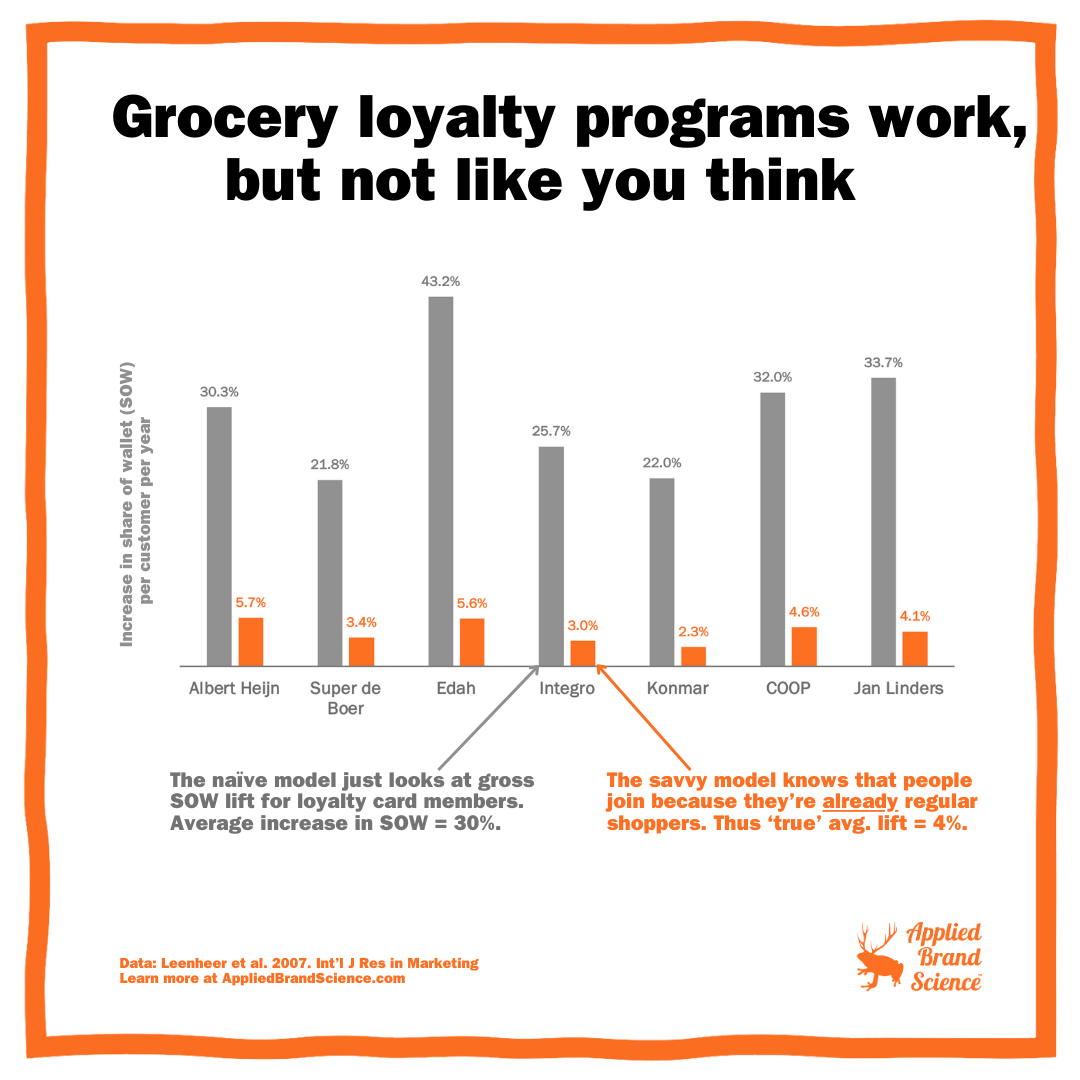
Do Grocery Loyalty Programs Work?
Dr. Jorna Leenheer & Co looked at data for 1,900 Dutch households over 2 years, covering 20 supermarkets and all 7 grocery loyalty programs.

Does travel ‘consumption’ follow brand laws?
Unless you have one client and it’s the Dept of Defense, you probably have a banana curve of buyers. It might be when measured over years for B2B accounts, or for weeks for coffee shops. But it’s quite the universal pattern.

Do brands grow via loyalty or penetration?
It’s an age-old debate: acquire new customers, or try to get current customers to buy more?
Let’s look at Dove, one of the very very few global grocery brands to post 10 straight years of growth.

What’s the “car door thunk” in your category?
It’s an open secret that the sound the car door makes when you close it has an oddly huuuge impact on how you assess the car’s quality.
This is because our brains are leaky: impressions we get in one area bleed into other areas. It’s called the halo effect.

How Do You Handle the Brand-Catagory Paradox?
How do you stand out while fitting in?
This is the Brand-Category Paradox: how to deliver category basics but in distinct, branded ways. Fortunately there are lots of Levers you can pull to help handle it.

Want better recall for your ads?
After getting a lot of “I don’t remember” and “uh, I think it was for Lindt…”, they did some math to find out how much brand recall would change given different numbers and types of mentions. (Go math!)
Increasing the number of mentions increased the chance of recall for all types of mentions, from a 17% boost to a 56% boost.

Is customer satisfaction overrated?
Like, does it really matter if people say they’re ”highly satisfied” with your brand?
It turns out the evidence is… mixed.

Are expensive spirits sold in heavier bottles?
Shouldn’t nicer spirits be sold in thick-walled, faceted, hefty bottles?
Turns out there’s less than a 20% correlation between price & weight. (The Rsq of the linear regression is a measly 0.039. 😂)
As a marketer and brand scientist (and the proprietor of a speakeasy), it baffles me that bottle weight isn’t used more often as a symbol of quality for the liquid inside.

Does click-through rate actually matter?
Did CTR correlate with ad recall? Nope. Less than 1%, in fact.
How about brand awareness? Nope. Or purchase intent? Nope nope. Both less than 1%.
But surely ROI? Ha. ROI had a -0.07% correlation with CTR. 😂😂😂

Are there small brands with high “loyalty”?
Like, are there brands with low household penetration but high buy rate?
The TL;DR: no. Not really. Like hardly ever. Like nearly never.
F’rinstance, Colgate is for sale around the world. But it’s in a different situation in each country.
Turns out, penetration moves in lock-step with buy rate. Like, really really tightly too.

Running radio ads? Fix your brand linkage!
If someone hears your ad on the radio, can they even say what brand it’s for?
System 1 Research & Radiocentre tested 131 radio ads in the UK.
Shockingly — I mean, it’s _right_after_the_ad_played_ — 40% of the ads had poor linkage.

Should you trust in-platform attribution models?
Attribution is tricky. Last-click attribution is also, uh, sketchy. Why?
1. It often confuses correlation with causation. Did views CAUSE sales or just correlate with them?
2. It rarely accounts for 10 or 12 other factors that are likely involved.
3. It’s got conflict-of-interest built in: of COURSE a platform wants to claim brand lift or sales impact or whatnot.

Do Small Brands Follow the Law of Double Jeopardy?
Small brands are weird. How weird are they?
In the kombucha category, f’rinstance, big brands like GT’s have higher penetration AND higher ‘loyalty’.
This is the Law of Double Jeopardy. It’s an empirical regularity, with nice equations that predict it quite, uh, nicely.

Do platforms “own” their users?
TL;DR: Nope.
As a sequel to last week’s post (Do brands “own” their buyers?), here’s another set of cross-usage data. This time for social media.
We like to think we “own” our users. Or that “our” users are totes not like “their” users. Pinterest vs LinkedIn. Facebook vs Snapchat.
But it’s more complex than that.

Do we “own” our customers?
We often like to think we “own” our customers.
That “our” buyers are totes not like “their” buyers.
Coke vs Pepsi. Coach vs Chanel. Home Depot vs Lowe's.
But it mostly ain’t so.

How Much Do Ad Agencies Love Young People?
*Obvi that means old people are, uh, well, ah.
“It’s not that you’re… We’re just going in a different direction…”
(I can neither confirm nor deny whether this is a real quote spoken to me.)

How much organic food do people rilly buy?
Like, do “organic people” spend all their money on organics? What’s the ‘share of wallet’ for organics?
An analysis of purchase data for 8,000 German households found that only 4% of homes spent 20% or more of their food budget on organic food.

Can music influence what people buy?
Like, can music subtly or subconsciously change people’s behavior?
For two weeks, folks from the University of Leicester did a little field experiment.

What do you do when no one trusts your profession?
Ipsos asked 1,000 British adults about a bunch of professions.
For each one, they simply asked, “tell me if you generally trust them to tell the truth or not.”
At the very bottom? Advertising Executives.

What happens when AI eats its own tail?
The big LLMs (ChatGPT, Midjourney, Stable Diffusion, etc.) are trained on massive piles of scraped “public” data.
(Btw: “Paging the Copyright Cops.” I mean, wtf!)
A couple of new studies show that when AI starts training itself on its own AI-generated output, results degrade until it’s just craptastic gobbledygook.
